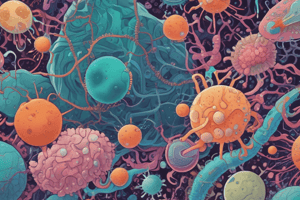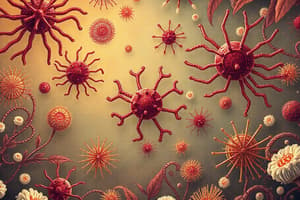Podcast
Questions and Answers
What is microbiology primarily concerned with?
What is microbiology primarily concerned with?
- The examination of immune system cells
- The study of visible organisms in the environment
- The exploration of pathogen-resistant crops
- The study of microscopic organisms or microbes (correct)
Which of the following groups is NOT a major type of microorganism studied in microbiology?
Which of the following groups is NOT a major type of microorganism studied in microbiology?
- Algae
- Protozoa
- Nematodes (correct)
- Fungi
What does bacteriology specifically study?
What does bacteriology specifically study?
- Bacteria (correct)
- Fungi
- Protozoa
- Viruses
Which of the following statements about normal flora is true?
Which of the following statements about normal flora is true?
The study of viruses falls under which branch of microbiology?
The study of viruses falls under which branch of microbiology?
Which division of microbiology is concerned with the relationship between microbes and agriculture?
Which division of microbiology is concerned with the relationship between microbes and agriculture?
Which of the following roles do microorganisms NOT typically fulfill?
Which of the following roles do microorganisms NOT typically fulfill?
What is the primary focus of immunology within the field of microbiology?
What is the primary focus of immunology within the field of microbiology?
What term describes the study of the relationship between microorganisms and the environment?
What term describes the study of the relationship between microorganisms and the environment?
Which of the following describes the role of saprophytes?
Which of the following describes the role of saprophytes?
What is a potential risk of taking antibiotics concerning microorganisms?
What is a potential risk of taking antibiotics concerning microorganisms?
Which of these microorganisms is known to cause Anthrax?
Which of these microorganisms is known to cause Anthrax?
What is one application of microorganisms in biotechnology?
What is one application of microorganisms in biotechnology?
How do probiotics benefit individuals after antibiotic use?
How do probiotics benefit individuals after antibiotic use?
Which biogeochemical cycle is significantly influenced by certain microorganisms?
Which biogeochemical cycle is significantly influenced by certain microorganisms?
What is the process called in which microorganisms are used to produce substances like insulin?
What is the process called in which microorganisms are used to produce substances like insulin?
What was John Needham's contribution to the theory of spontaneous generation?
What was John Needham's contribution to the theory of spontaneous generation?
How did Lazzaro Spallanzani challenge the theory of spontaneous generation?
How did Lazzaro Spallanzani challenge the theory of spontaneous generation?
What did Louis Pasteur's Swan-Neck Flask experiment demonstrate?
What did Louis Pasteur's Swan-Neck Flask experiment demonstrate?
What significant theory did Louis Pasteur propose?
What significant theory did Louis Pasteur propose?
Which of the following contributions is attributed to Robert Koch?
Which of the following contributions is attributed to Robert Koch?
What did Edward Jenner discover in 1800?
What did Edward Jenner discover in 1800?
What did Joseph Lister apply in medical procedures?
What did Joseph Lister apply in medical procedures?
What concept did Elias Metchnikoff advance regarding the immune system?
What concept did Elias Metchnikoff advance regarding the immune system?
What was a major characteristic of medical practices during the Era of Superstitious Belief and Speculation?
What was a major characteristic of medical practices during the Era of Superstitious Belief and Speculation?
Who is known as the Father of Microbiology?
Who is known as the Father of Microbiology?
What discovery is Robert Hooke credited with?
What discovery is Robert Hooke credited with?
Which of the following statements reflects the theory of spontaneous generation?
Which of the following statements reflects the theory of spontaneous generation?
What common practice was associated with attempts to cure diseases in ancient times?
What common practice was associated with attempts to cure diseases in ancient times?
Which scientist challenged the theory of spontaneous generation by demonstrating that maggots do not arise from decaying meat?
Which scientist challenged the theory of spontaneous generation by demonstrating that maggots do not arise from decaying meat?
What critical tool was developed during the Era of Observation that aided in the study of microorganisms?
What critical tool was developed during the Era of Observation that aided in the study of microorganisms?
What significant change occurred in the understanding of diseases by the mid-19th century compared to ancient practices?
What significant change occurred in the understanding of diseases by the mid-19th century compared to ancient practices?
What was the significance of Paul Ehrlich's discovery in 1909?
What was the significance of Paul Ehrlich's discovery in 1909?
Which discovery is associated with Alexander Fleming?
Which discovery is associated with Alexander Fleming?
How did the electron microscope contribute to microbiology?
How did the electron microscope contribute to microbiology?
What major understanding about genes was achieved by the 1940s?
What major understanding about genes was achieved by the 1940s?
What role did the development of restriction enzymes play in biotechnology?
What role did the development of restriction enzymes play in biotechnology?
What virus was discovered by Luc Montagnier and Robert Gallo?
What virus was discovered by Luc Montagnier and Robert Gallo?
Which of the following statements about biotechnology is true?
Which of the following statements about biotechnology is true?
Which advancement in microbiology occurred in the 1950s to 1960s?
Which advancement in microbiology occurred in the 1950s to 1960s?
Flashcards are hidden until you start studying
Study Notes
Introduction to Microbiology
- Microbiology is the study of microorganisms, including bacteria, protozoa, algae, fungi, helminths, and viruses.
- Microorganisms are also known as microbes, germs, or bugs.
- Microbiology encompasses various aspects of microbes: their genetics, physiology, disease-causing or beneficial properties, interactions with the environment and hosts, and industrial and agricultural applications.
Divisions of Microbiology
- Bacteriology: study of bacteria
- Mycology: study of fungi
- Phycology: study of algae
- Parasitology: study of parasites, including protozoa, helminths, and arthropods
- Protozoology: study of protozoa
- Virology: study of viruses
- Immunology: study of the immune system's response to infection
- Public Health Microbiology and Epidemiology: monitor and control disease spread in communities
- Biotechnology: utilizes biological systems for product development
- Agricultural Microbiology: focuses on the relationship between microbes and crops, including yield enhancement and disease control
Roles of Microorganisms
- Normal Flora: Numerous microorganisms reside in the human body, forming the normal flora (or microbiota). They can be pathogenic (disease-causing) or non-pathogenic, and some are beneficial for maintaining health.
- Biotechnology: Microorganisms are crucial in biotechnology, used to produce foods, beverages, and antibiotics.
- Saprophytes: Microorganisms, particularly bacteria and fungi, act as decomposers, breaking down waste and dead organisms.
- Biogeochemical Cycles: Microorganisms play a vital role in biogeochemical cycles, like the nitrogen cycle, and break down organic substances to release nutrients like nitrates and phosphates, crucial for plant growth.
- Genetic Engineering: Microorganisms are used in genetic engineering to produce substances like insulin and interferon.
- Biological Warfare Agents: Some microorganisms and their toxins, like Anthrax (Bacillus anthracis), are potential biological warfare agents.
Probiotics
- Probiotics are live microorganisms similar to beneficial bacteria found in the human gut.
- They are also called "friendly" or "good bacteria."
- Probiotics are available in foods like yogurt and dietary supplements.
- They can help restore beneficial bacteria after antibiotic use, but can be dangerous in individuals with compromised immune systems.
History of Microbiology
The Era of Superstitious Belief and Speculation (5000 BC to 1675)
- Ancient medical practices were heavily influenced by superstitious beliefs with no understanding of disease causation.
- Treatments included burning incense, aromatic oils, ringing bells, talismans, urine baths, dead animal placement, leeching, bloodletting, ingesting gold or emeralds, and flagellation.
- The concept of quarantine was already implemented to isolate infected individuals.
The Era of Observation (1675 to mid-19th century)
- Increased curiosity led to the development of tools for investigation.
- Robert Hooke (1665): Discovered the cell, the basic unit of life, leading to the development of the Cell Theory.
- Anton van Leeuwenhoek (1676): Considered the Father of Microbiology, he was the first to observe microscopic organisms (animalcules), paving the way for exploring the microscopic world. He provided detailed descriptions of protozoa, fungi, and bacteria.
- The theory of spontaneous generation, which stated that microorganisms arise from lifeless matter, was prevalent during this era.
- Francesco Redi: Disputed spontaneous generation by demonstrating that fly maggots do not arise from decaying meat.
- John Needham and Lazzaro Spallanzani: Debated spontaneous generation. Spallanzani showed that boiled broth would only give rise to microorganisms if exposed to air.
- Alcohol, vinegar, and beer production began during this time, although the underlying biochemical processes were not fully understood.
The Era of Disproving Spontaneous Generation (1850s to 1870s)
- Louis Pasteur (1859): Disproved spontaneous generation with his Swan-Neck Flask Experiment. He also investigated the role of microorganisms in fermentation, solved the mystery of sour wine, developed pasteurization to kill microorganisms in liquids, and proposed the Germ Theory of Disease.
- John Tyndall: Identified the heat resistance of certain microbes in dust and air.
The Era of Germ Theory and Koch's Postulates (1870s to 1880s)
- Robert Koch (Father of Bacteriology): Proved Pasteur's Germ Theory and established Koch's Postulates, a set of criteria to determine the causal relationship between a specific organism and a specific disease. He pioneered techniques for preparing, staining, and permanently preserving bacterial specimens for microscopy, leading to the first photomicrographs of bacteria.
- Edward Jenner (1800): Developed the first vaccine, for smallpox virus.
- Ferdinand Cohn (1849): Discovered endospores (heat-resistant bacterial forms) and introduced the use of vegetable dyes for staining histological sections.
- Joseph Lister (1867): Applied the Germ Theory to medical procedures, leading to the development of aseptic (sterile) surgery.
- Hans Christian Gram (1884): Developed the Gram-staining procedure, a crucial technique for differentiating bacteria.
- Elias Metchnikoff: Pioneered the theory of cellular immunity, demonstrating that white blood cells protect against invading microbes.
The Era of Chemotherapy (19th Century)
- Paul Erlich (1909): Discovered Salvarsan, the "magic bullet" for treating syphilis, ushering in the era of chemotherapy.
- Alexander Fleming (1928): Discovered penicillin, the first antibiotic, which revolutionized medical treatment by selectively killing microorganisms.
The Era of Electron Microscopy and Viral Cultivation (1930s to 1940s)
- Max Knoll and Ernst Ruska (1931): Invented the electron microscope, enabling higher-resolution visualization of microorganisms and revealing their cellular nature.
- Methods for cultivating viruses were developed, leading to the rapid advancement of research, particularly during World War II.
The Era of DNA and Vaccines (1940s to 1960s)
- Genes were understood as discrete units of heredity that control metabolic functions.
- Oswald T. Avery (1944): Showed that DNA, a ubiquitous molecule, was the chemical basis for heritable transformations in bacteria.
- Development of vaccines for polio, measles, mumps, and rubella took place.
- Luc Montagnier and Robert Gallo: Discovered the Human Immunodeficiency Virus (HIV) and acquired immunodeficiency syndrome (AIDS).
The Era of Biotechnology (1970s to Present)
- Advancements in bacterial physiology, biochemistry, and genetics enabled manipulation of the genetic material of living organisms.
- The invention of restriction enzymes allowed for introducing foreign DNA into bacteria, leading to the development of biotechnology.
- Microorganisms are utilized as “living factories” to produce pharmaceuticals like insulin, interferon, blood-clotting factors, clot-dissolving enzymes, and vaccines.
- Bacteria can be engineered to enhance plant resistance to insects and frost.
Studying That Suits You
Use AI to generate personalized quizzes and flashcards to suit your learning preferences.




